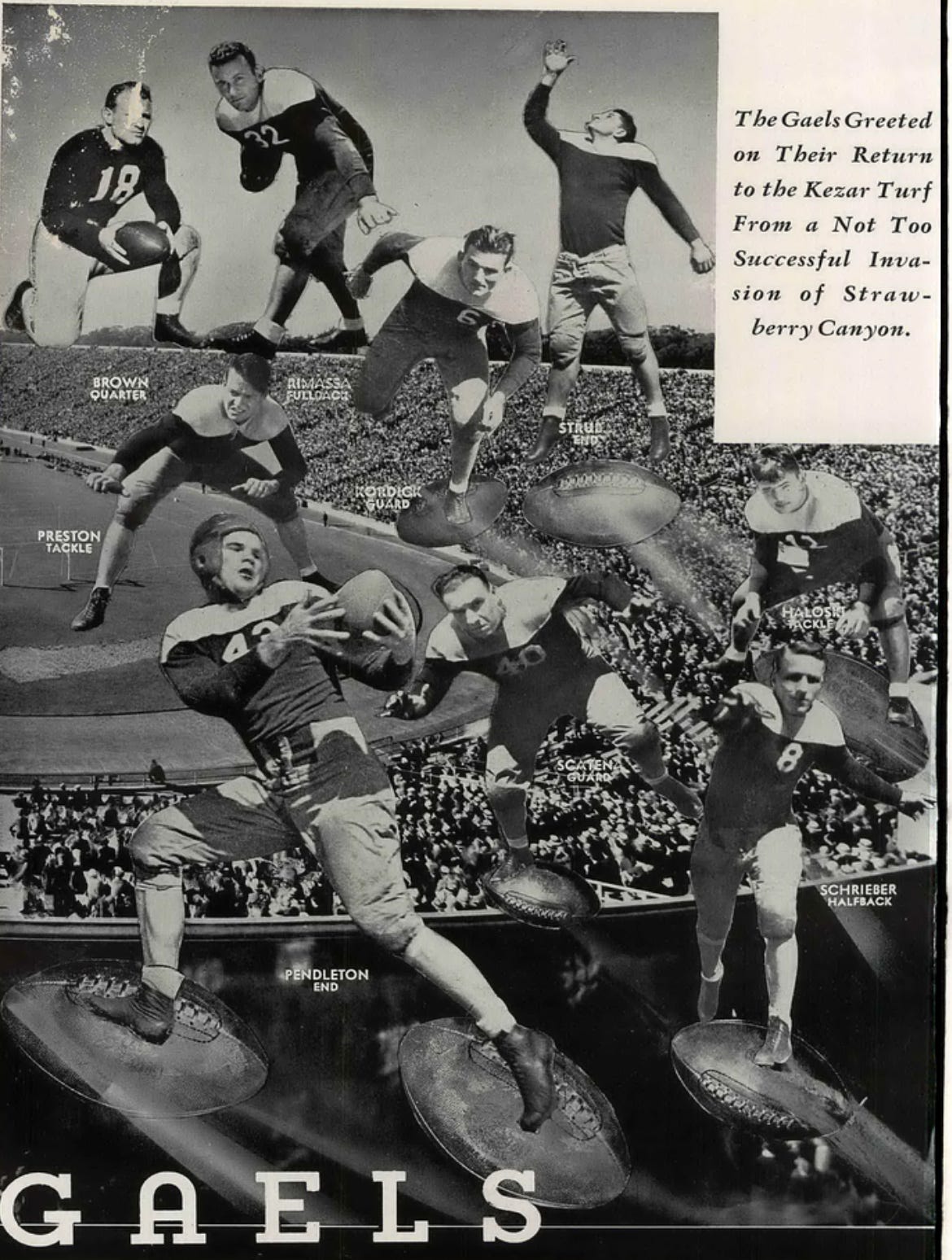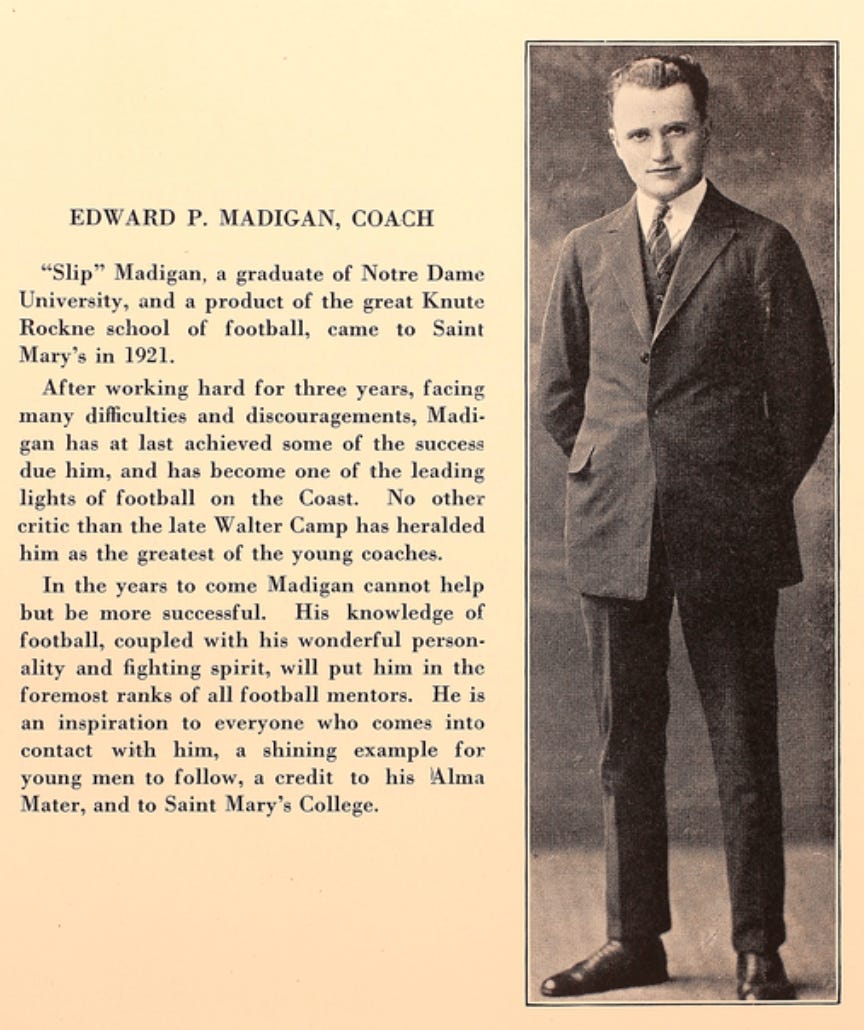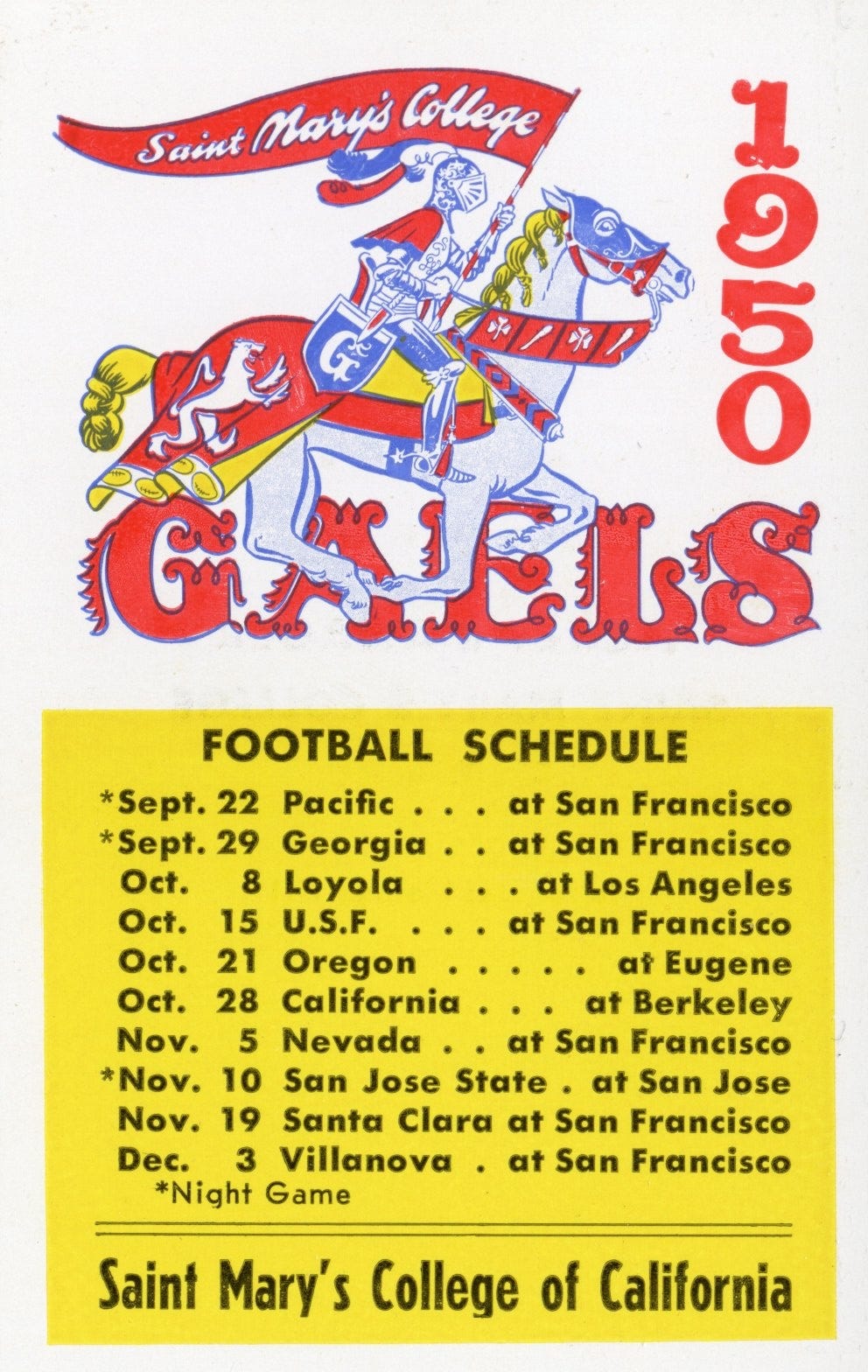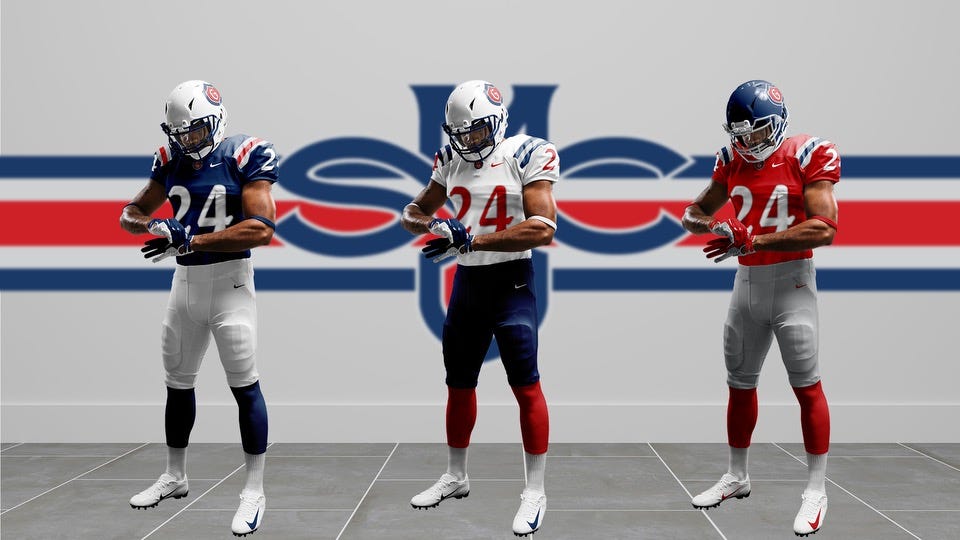Stadium Size, Football Droppers, and Deemphasizers: St. Mary's
St. Mary's College originated in San Francisco, moved across the Bay to Oakland in 1889, and shifted further east to Moraga in 1928 following a significant fire on the Oakland campus. The Gaels played a handful of football games in the 1800s, stopped for a time, and restarted in 1915, playing football during the war.
St. Mary's lost 127-0 to Cal in 1920. Looking to enhance their football fortunes, they went the standard Catholic college route of hiring a former Notre Dame player, Edward "Slip" Madigan, who was just what the doctors of divinity ordered.
Madigan, a strong recruiter, showman, and creative tactician, coached the Gaels from 1921 through 1939. During his time there, the Gaels became a national power, beating the top teams in California and traveling East to play Fordham annually, substituting Boston College or Villanova some years. Intersectional opponents that played St. Mary's at San Francisco's 60,000-seat Kezar Stadium home included SMU, Alabama, Duquesne, Detroit, and Georgia. They played several games yearly against Pacific Coast Conference foes and filled the rest of the schedule with other California institutions, especially of the Catholic variety.
They won six of their nine games most years and went undefeated in 1926 and 1929 before the modern bowl system started. Once postseason play became more common, they played in the 1939 Cotton Bowl, 1946 Cotton Bowl, and 1947 Oil Bowl.
Throughout the 1930s, St. Mary's often packed Kezar Stadium for the intersectional games, the PCC foes, and their rivalry game with Santa Clara, usually called the Little Big Game.

Attendance became a challenge after WWII as fans found other things to do on Saturdays and Sundays, including watching football on the emerging medium of television. St. Mary’s wasn’t alone. The PCC banned televising league games for the 1951 season, just as the Big Ten had in 1950, hoping to remedy their attendance drops.
Unlike the big state schools or more deep-pocketed private schools, St. Mary's had little extra cash and a small student body. There were only 900 students in 1950 and about 2,000 undergraduates today. With an athletic program dependent on the cash flow generated by football ticket sales, the drop in game attendance made football unsustainable, leading to the school dropping football after the 1950 season.
In retrospect, St. Mary's dropping football is less surprising than their ability to play at the highest level for as long as they did. They were competitive before WWII and the onset of two-platoon football because every team had a small coaching staff, with coaches handling several sports or other jobs. Single-platoon teams needed half the number of players, scholarships, equipment, and everything else; even travel costs were lower.
Even then, the Gaels expenses didn't spend much on travel near the end. In 1950, they played Loyola Marymount in Los Angeles and Oregon in Eugene, while their other eight games were played in the Bay Area, including away games at Cal and San Jose State. Their attendance and attention problem had more to do with too many college programs in the Bay area seeking attention: San Francisco, Cal, San Jose State, Santa Clara, and Pacific (80 miles east in the Central Valley) were on their 1950 schedule, plus Stanford.
With the school facing a $100,000 football deficit from the 1950 season and students enlisting and getting drafted due to the war in Korea, the school announced its intention to drop football and baseball for the duration of the conflict:
[The] action of the board followed consideration of the prospective depletion in student enrollment, consequent on selective service and voluntary enlistments in the armed forces, the financial loss entailed in maintaining a major athletic program and the growing difficulty of sustaining academic standards in the face of an inflated competition, particularly football.
'Gaels Quit Football, Baseball For Duration,' Fresno Bee, January 5, 1951.
The duration lasted until 1970, when football came back at the DIII level, before moving up to DII in 1980 and to DI-AA, now FCS, from 1993 to 2003.
St. Mary's did not have a home stadium when it was a football power. However, the 5,500-seat St. Mary's Stadium, built in 1973, continues to be used for soccer and other sports today.
Next up: University of California, Santa Barbara
2024 Concept Uniform
My brother, Steve, dabbles in sports team logos and uniforms. Here are his concept uniforms for St. Mary’s imaginary 2024 team.
Ranking by Stadium Size
Below are the schools reviewed to date, ranked by stadium size. The stadiums’ opening and demolition years (if applicable) are also noted.
Catholic (Brookland Stadium): 30,000 | 1924 - 1985
Denver (DU/Hilltop Stadium): 30,000 | 1925 - 1971
Marquette (Marquette Stadium): 24,000 | 1924 - 1977
Xavier (Corcoran Stadium): 15,000 | 1929 - 1988
Gonzaga (Gonzaga Stadium): 12,000 | 1922 - 1949
California State University, Fullerton (Titan Stadium): 10,000 | 1992 - TBD
Boston University (Nickerson Field): 10,000 | 1915 - TBD
Vermont (Centennial Field): 10,000 | 1923 - TBD
St. Mary’s (St. Mary’s Stadium) 5,500 | TBD
NYU (Ohio Field): 5,000 (est.) | 1897 - 1947
San Francisco (St. Ignatius Stadium): <5,000 (est.) | c. 1909 - c. 1930
Carnegie-Mellon (Skibo Bowl): 4,500 | 1960 - 1987 | Gesling Stadium: 3,900 | 1990 - TBD
Sewanee (McGee Field): 3,000 | 1891 - TBD
Schools to Review
California State University, Long Beach | Case Western | Chicago | CCNY | Creighton | DePaul | Detroit | Drake | Loyola (Chicago) | Nebraska-Omaha | Pacific | St. Louis | Santa Clara | Tampa | Washington University in St. Louis | Wichita State
Click here for options on how to support this site beyond a free subscription.





Great writing and research on this one, Tim!